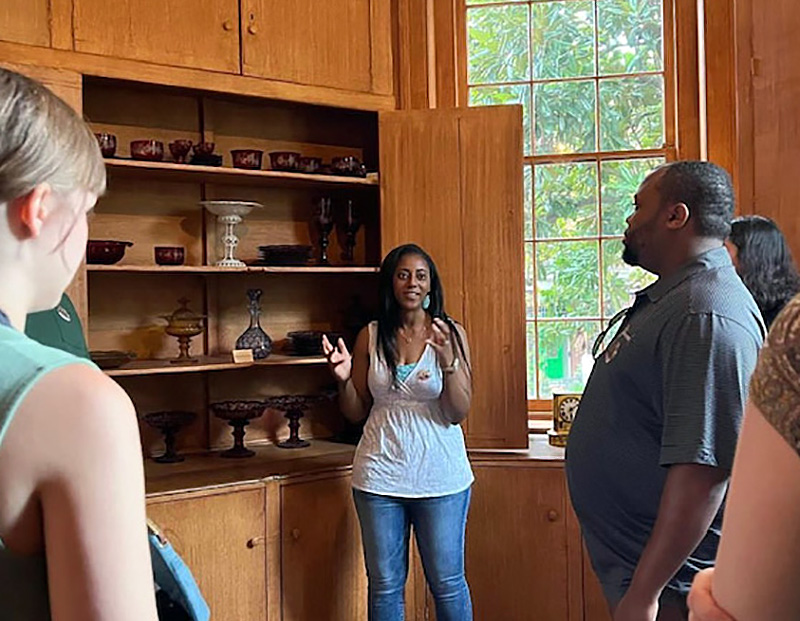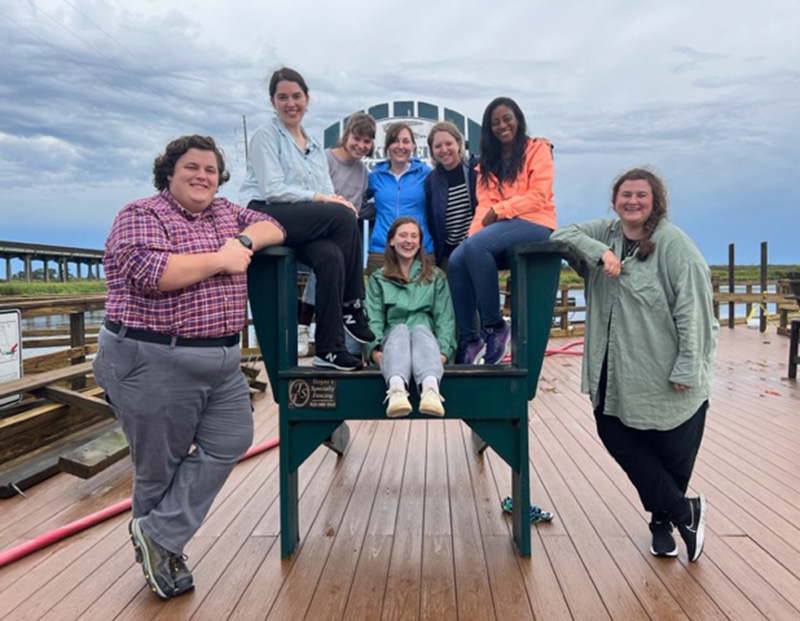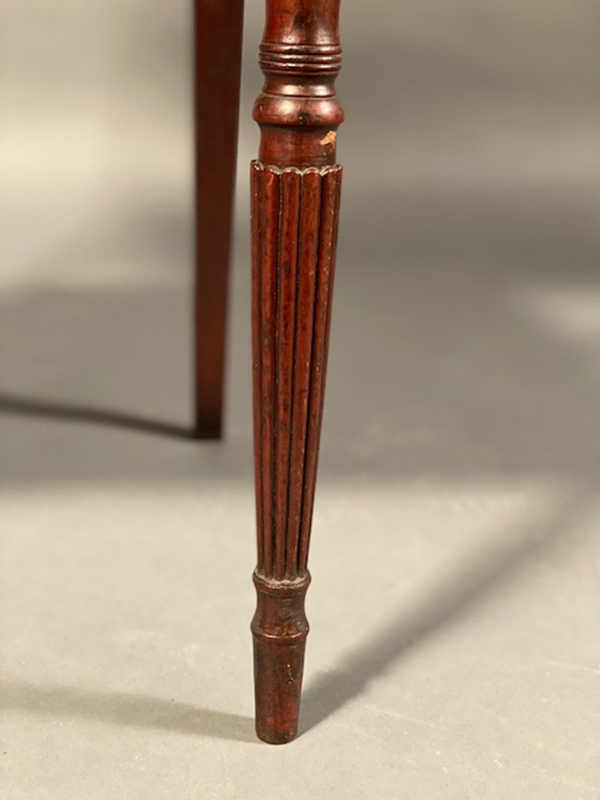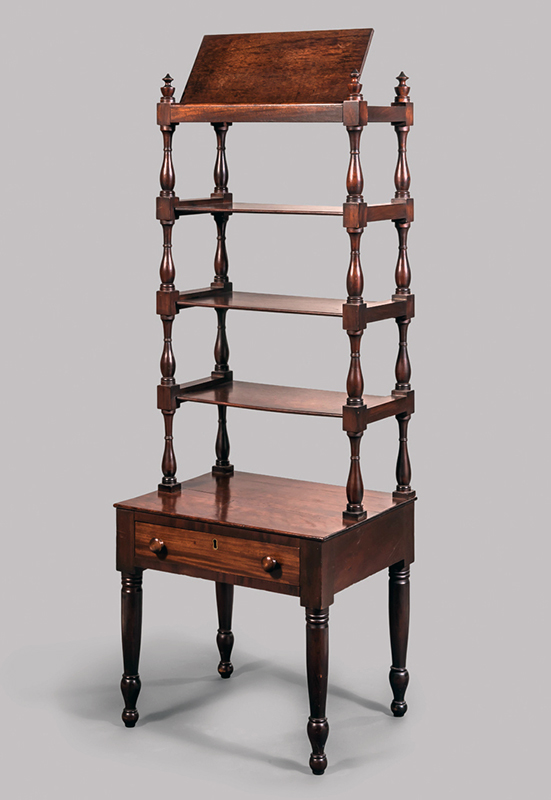A Note-Worthy Perspective: The Role of Young Women in Music Education
by Ahmauri Williams-Alford
As the recipient of the William C. and Susan S. Mariner Fellowship for Emerging Museum Professionals sponsored by the Decorative Arts Trust, I had the monumental opportunity to attend the 2023 Museum of Early Southern Decorative Arts (MESDA) Summer Institute. The rigorous yet rewarding course consisted of in-depth analysis of the history and material culture of the Lowcountry, including coastal South Carolina and Georgia. The Summer Institute Fellows gained hands-on experience with MESDA’s unparalleled collection of early Southern furniture, ceramics, silver, and paintings. To complement our intensive study, we took a productive excursion through the Lowcountry (figure 1 and 2) and immersed ourselves in conversations with scholars and other museum professionals about ongoing research in interpretation, archaeology, and architecture.
Figure 1. Ahmauri Williams-Alford (center) giving a tour to the 2023 MESDA Summer Institute at the Owens-Thomas House & Slave Quarters in Savannah, GA.
As an assistant curator of historical interpretation at Telfair Museums, I focus on creating stories that use tangible objects to convey intangible ideas. Engaging in dialogue with other professionals in the same discipline strengthened my understanding of the role material culture plays in history and helped sharpen my skill of crafting object-based narratives to share with the public. My summer research project centered on an early-19th-century music stand attributed to Savannah, GA (figure 3). The stand has little provenance, with its Savannah attribution largely based upon the secondary wood composition of yellow pine. Therefore, instead of creating a narrative that connected the object to a family or a maker, I explored the perceived multifunctionality of the stand and its possible interactions between young women of different social classes.
The music stand, crafted between 1810–20, is designed in a Neoclassical design popular in the United States and falls under the general guidelines of what is referred to as the Sheraton style. The simple form is also paired with simple ornamentation, with motifs such as urn-shaped finials and reeded legs (figures 4 and 5). With the distinctive tiered shelving, I argued that it also could have been used for display, a form called an étagère. First published in 1833, J.C. Loudon’s Encyclopedia of Cottage, Farm, and Villa Architecture and Furniture classifies a similar object as being used for both.1 The shelves could have held manuscripts and other trinkets, while the lidded compartment likely served as additional storage. On the topmost shelf sits the tray for the manuscript, which was usually bound in volumes, and likely would have rested there on display. Another comparison similar to this form, made of the same materials, is also represented in MESDA’s collection, but attributed to Charlotte County, VA (figure 6).
Figure 4. Finial detail of Music Stand, 1810–20, attributed to Savannah, GA. Mahogany, yellow pine. Museum of Early Southern Decorative Arts, gift of Frank L. Horton, 2475.
Women in the 19th century demonstrated their refinement with a varied repertoire of accomplishments in drawing, needlework, and music. Music was a sign of prestige extended across a wide spectrum. Advertisements in Savannah newspapers promoted several music lessons for piano, harp, and guitar. Music was also integrated into many local school curriculums.2 A music stand would have been a beneficial object to have in the home to help ensure a young woman’s music education, and women within the upper, middle, and lower class would have understood its importance. Within the home, the drawing room or front parlor were likely spaces where music took place. Young girls often practiced variations of popular melodies like “Auld Lang Syne” to polkas, waltzes, and occasionally religious pieces.
Access to proper music education was a big expenditure. Upper class Savannahian women had the ability to buy instruments, sheet music, and secure the best teachers. For women in the middle class, many worked to acquire the funds needed to acquire their music education. However, the ability to practice music among both classes indicates another expenditure others were not afforded: time. Having the ability to enjoy leisurely pursuits like music education was constrained among a certain demographic based on restrictive laws that curtailed attempts toward education.
Young, enslaved girls labored in the homes of Savannahians and took on domestic labor duties that spanned throughout most of their day. Unlike their white counterparts, they did not have access to formal education due to anti-literacy laws. Formal music education likely fell under these regulations. Instead, they would have been tasked with routine maintenance and cleaning of furniture like the stand, ensuring that it remained polished and pristine to keep up with the appearance of the family and the room.
However, there are instances of free Black women obtaining musical education. The children of Nathan Sayre, a white landholder and judge, and Susan Hunt, a free Black woman, studied music at Sparta Female Model School in Hancock County, GA. Likewise, the Oblate Sisters of Providence Convent in Baltimore allowed free women of color to board there and receive an education that embraced music.3
This music stand illuminates how music in the 19th century conferred value, in this case social and cultural capital, and those aspiring to achieve it were not affixed to a singular social status. Though mere vignettes of a larger interpretive story, the Mariner Fellowship gave me the tools to challenge myself when I think of how the presence of objects dictates the types of interactions we have with them. Through the generosity of the Mariners and the Decorative Arts Trust, I aim to bring this experience and the skills I have learned into my field as I continue my efforts to form more inclusive and complete object-based narratives.
1. J.C. Loudon, An Encyclopedia of Cottage, Farm, and Villa Architecture and Furniture, (London, Brown, Green & Longmans, 1846), 302.
2. Advertisement, Savannah Daily Republican, January 30, 1821, Georgia Historic Newspapers.
3. Candace Bailey, Unbinding Gentility: Women Making Music in the Nineteenth Century South, 1st ed. (Urbana: University of Illinois Press, 2021), 67.
Ahmauri Williams-Alford is an Assistant Curator of Historical Interpretation at Telfair Museums.
About The Decorative Arts Trust Bulletin
Formerly known as the "blog,” the Bulletin features new research and scholarship, travelogues, book reviews, and museum and gallery exhibitions. The Bulletin complements The Magazine of the Decorative Arts Trust, our biannual members publication.
Click Images to Enlarge
Did you know that clicking on the images in Bulletin posts will allow you to get a closer look? Simply click on an image, and a larger version will open in a pop-up window.













